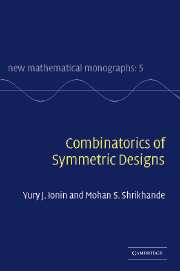Book contents
- Frontmatter
- Contents
- Preface
- 1 Combinatorics of finite sets
- 2 Introduction to designs
- 3 Vector spaces over finite fields
- 4 Hadamard matrices
- 5 Resolvable designs
- 6 Symmetric designs and t-designs
- 7 Symmetric designs and regular graphs
- 8 Block intersection structure of designs
- 9 Difference sets
- 10 Balanced generalized weighing matrices
- 11 Decomposable symmetric designs
- 12 Subdesigns of symmetric designs
- 13 Non-embeddable quasi-residual designs
- 14 Ryser designs
- Appendix
- References
- Index
5 - Resolvable designs
Published online by Cambridge University Press: 26 February 2010
- Frontmatter
- Contents
- Preface
- 1 Combinatorics of finite sets
- 2 Introduction to designs
- 3 Vector spaces over finite fields
- 4 Hadamard matrices
- 5 Resolvable designs
- 6 Symmetric designs and t-designs
- 7 Symmetric designs and regular graphs
- 8 Block intersection structure of designs
- 9 Difference sets
- 10 Balanced generalized weighing matrices
- 11 Decomposable symmetric designs
- 12 Subdesigns of symmetric designs
- 13 Non-embeddable quasi-residual designs
- 14 Ryser designs
- Appendix
- References
- Index
Summary
An affine plane of order n has n2 + n lines, any two of which are either parallel or intersecting. The relation of parallelism on the set of lines is an equivalence relation, and so it partitions the set of lines into n + 1 parallel classes of cardinality n. Each point lies on exactly one line from each parallel class. The block set of the complement of an affine plane of order n can be partitioned into n + 1 classes so that each point is contained in exactly n – 1 blocks from each class. Similar partitions exist in affine geometries of higher dimension. In this chapter we study a more general notion of resolution of an incidence structure, i.e., a partition of the block set of the structure into classes so that each point is contained in a constant number of blocks from each class.
Bose's Inequality
The incidence structures on which we define the notion of resolution are pairwise balanced designs.
Definition 5.1.1. Let λ be a positive integer. A pairwise balanced design (PBD) of index λ is an incidence structure D = (X, B, I) such that X ≠ Ø, every x ∈ X is incident with more than λ blocks, and, for any distinct x, y ∈ X, there are precisely λ blocks that are incident with both x and y. If a PBD of index λ has constant replication number r, it is called an (r, λ)-design.
- Type
- Chapter
- Information
- Combinatorics of Symmetric Designs , pp. 154 - 185Publisher: Cambridge University PressPrint publication year: 2006



